Hengyuan Zhang
Quantifying the Robustness of Retrieval-Augmented Language Models Against Spurious Features in Grounding Data
Mar 07, 2025Abstract:Robustness has become a critical attribute for the deployment of RAG systems in real-world applications. Existing research focuses on robustness to explicit noise (e.g., document semantics) but overlooks spurious features (a.k.a. implicit noise). While previous works have explored spurious features in LLMs, they are limited to specific features (e.g., formats) and narrow scenarios (e.g., ICL). In this work, we statistically confirm the presence of spurious features in the RAG paradigm, a robustness problem caused by the sensitivity of LLMs to semantic-agnostic features. Moreover, we provide a comprehensive taxonomy of spurious features and empirically quantify their impact through controlled experiments. Further analysis reveals that not all spurious features are harmful and they can even be beneficial sometimes. Extensive evaluation results across multiple LLMs suggest that spurious features are a widespread and challenging problem in the field of RAG. The code and dataset will be released to facilitate future research. We release all codes and data at: $\\\href{https://github.com/maybenotime/RAG-SpuriousFeatures}{https://github.com/maybenotime/RAG-SpuriousFeatures}$.
RoboBrain: A Unified Brain Model for Robotic Manipulation from Abstract to Concrete
Feb 28, 2025Abstract:Recent advancements in Multimodal Large Language Models (MLLMs) have shown remarkable capabilities across various multimodal contexts. However, their application in robotic scenarios, particularly for long-horizon manipulation tasks, reveals significant limitations. These limitations arise from the current MLLMs lacking three essential robotic brain capabilities: Planning Capability, which involves decomposing complex manipulation instructions into manageable sub-tasks; Affordance Perception, the ability to recognize and interpret the affordances of interactive objects; and Trajectory Prediction, the foresight to anticipate the complete manipulation trajectory necessary for successful execution. To enhance the robotic brain's core capabilities from abstract to concrete, we introduce ShareRobot, a high-quality heterogeneous dataset that labels multi-dimensional information such as task planning, object affordance, and end-effector trajectory. ShareRobot's diversity and accuracy have been meticulously refined by three human annotators. Building on this dataset, we developed RoboBrain, an MLLM-based model that combines robotic and general multi-modal data, utilizes a multi-stage training strategy, and incorporates long videos and high-resolution images to improve its robotic manipulation capabilities. Extensive experiments demonstrate that RoboBrain achieves state-of-the-art performance across various robotic tasks, highlighting its potential to advance robotic brain capabilities.
SMART: Advancing Scalable Map Priors for Driving Topology Reasoning
Feb 06, 2025Abstract:Topology reasoning is crucial for autonomous driving as it enables comprehensive understanding of connectivity and relationships between lanes and traffic elements. While recent approaches have shown success in perceiving driving topology using vehicle-mounted sensors, their scalability is hindered by the reliance on training data captured by consistent sensor configurations. We identify that the key factor in scalable lane perception and topology reasoning is the elimination of this sensor-dependent feature. To address this, we propose SMART, a scalable solution that leverages easily available standard-definition (SD) and satellite maps to learn a map prior model, supervised by large-scale geo-referenced high-definition (HD) maps independent of sensor settings. Attributed to scaled training, SMART alone achieves superior offline lane topology understanding using only SD and satellite inputs. Extensive experiments further demonstrate that SMART can be seamlessly integrated into any online topology reasoning methods, yielding significant improvements of up to 28% on the OpenLane-V2 benchmark.
Chain-of-Reasoning: Towards Unified Mathematical Reasoning in Large Language Models via a Multi-Paradigm Perspective
Jan 19, 2025Abstract:Large Language Models (LLMs) have made notable progress in mathematical reasoning, yet they often rely on single-paradigm reasoning that limits their effectiveness across diverse tasks. In this paper, we introduce Chain-of-Reasoning (CoR), a novel unified framework that integrates multiple reasoning paradigms--Natural Language Reasoning (NLR), Algorithmic Reasoning (AR), and Symbolic Reasoning (SR)--to enable synergistic collaboration. CoR generates multiple potential answers using different reasoning paradigms and synthesizes them into a coherent final solution. We propose a Progressive Paradigm Training (PPT) strategy that allows models to progressively master these paradigms, culminating in the development of CoR-Math-7B. Experimental results demonstrate that CoR-Math-7B significantly outperforms current SOTA models, achieving up to a 41.0% absolute improvement over GPT-4 in theorem proving tasks and a 7.9% improvement over RL-based methods in arithmetic tasks. These results showcase the enhanced mathematical comprehensive ability of our model, achieving significant performance gains on specific tasks and enabling zero-shot generalization across tasks.
MapGS: Generalizable Pretraining and Data Augmentation for Online Mapping via Novel View Synthesis
Jan 11, 2025Abstract:Online mapping reduces the reliance of autonomous vehicles on high-definition (HD) maps, significantly enhancing scalability. However, recent advancements often overlook cross-sensor configuration generalization, leading to performance degradation when models are deployed on vehicles with different camera intrinsics and extrinsics. With the rapid evolution of novel view synthesis methods, we investigate the extent to which these techniques can be leveraged to address the sensor configuration generalization challenge. We propose a novel framework leveraging Gaussian splatting to reconstruct scenes and render camera images in target sensor configurations. The target config sensor data, along with labels mapped to the target config, are used to train online mapping models. Our proposed framework on the nuScenes and Argoverse 2 datasets demonstrates a performance improvement of 18% through effective dataset augmentation, achieves faster convergence and efficient training, and exceeds state-of-the-art performance when using only 25% of the original training data. This enables data reuse and reduces the need for laborious data labeling. Project page at https://henryzhangzhy.github.io/mapgs.
BPO: Towards Balanced Preference Optimization between Knowledge Breadth and Depth in Alignment
Nov 16, 2024Abstract:Reinforcement Learning with Human Feedback (RLHF) is the key to the success of large language models (LLMs) in recent years. In this work, we first introduce the concepts of knowledge breadth and knowledge depth, which measure the comprehensiveness and depth of an LLM or knowledge source respectively. We reveal that the imbalance in the number of prompts and responses can lead to a potential disparity in breadth and depth learning within alignment tuning datasets by showing that even a simple uniform method for balancing the number of instructions and responses can lead to significant improvements. Building on this, we further propose Balanced Preference Optimization (BPO), designed to dynamically augment the knowledge depth of each sample. BPO is motivated by the observation that the usefulness of knowledge varies across samples, necessitating tailored learning of knowledge depth. To achieve this, we introduce gradient-based clustering, estimating the knowledge informativeness and usefulness of each augmented sample based on the model's optimization direction. Our experimental results across various benchmarks demonstrate that BPO outperforms other baseline methods in alignment tuning while maintaining training efficiency. Furthermore, we conduct a detailed analysis of each component of BPO, providing guidelines for future research in preference data optimization.
ShifCon: Enhancing Non-Dominant Language Capabilities with a Shift-based Contrastive Framework
Oct 25, 2024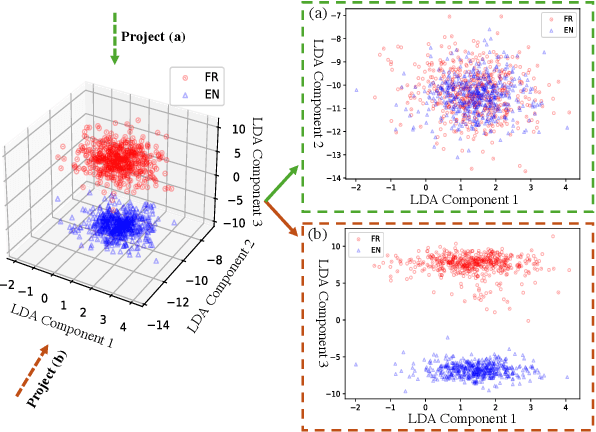
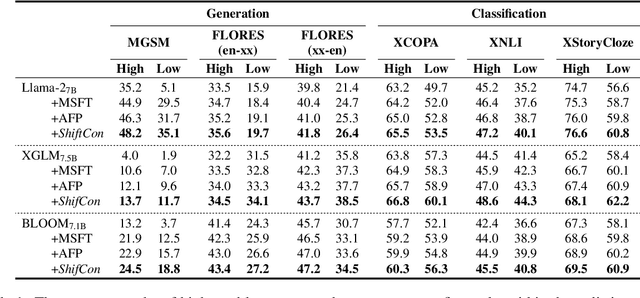
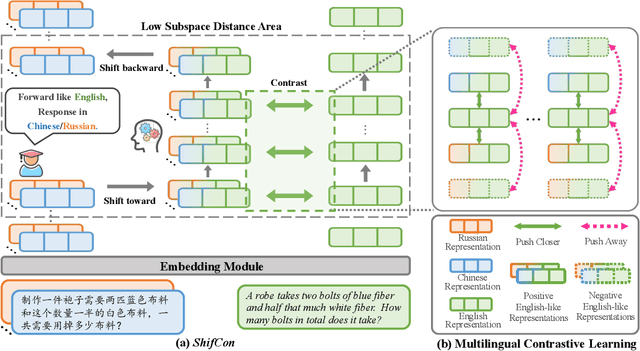
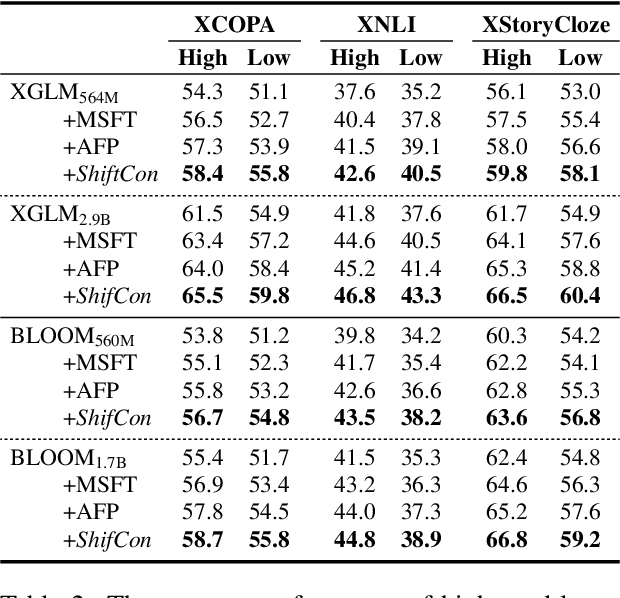
Abstract:Although fine-tuning Large Language Models (LLMs) with multilingual data can rapidly enhance the multilingual capabilities of LLMs, they still exhibit a performance gap between the dominant language (e.g., English) and non-dominant ones due to the imbalance of training data across languages. To further enhance the performance of non-dominant languages, we propose ShifCon, a Shift-based Contrastive framework that aligns the internal forward process of other languages toward that of the dominant one. Specifically, it shifts the representations of non-dominant languages into the dominant language subspace, allowing them to access relatively rich information encoded in the model parameters. The enriched representations are then shifted back into their original language subspace before generation. Moreover, we introduce a subspace distance metric to pinpoint the optimal layer area for shifting representations and employ multilingual contrastive learning to further enhance the alignment of representations within this area. Experiments demonstrate that our ShifCon framework significantly enhances the performance of non-dominant languages, particularly for low-resource ones. Further analysis offers extra insights to verify the effectiveness of ShifCon and propel future research
EVA: An Embodied World Model for Future Video Anticipation
Oct 20, 2024



Abstract:World models integrate raw data from various modalities, such as images and language to simulate comprehensive interactions in the world, thereby displaying crucial roles in fields like mixed reality and robotics. Yet, applying the world model for accurate video prediction is quite challenging due to the complex and dynamic intentions of the various scenes in practice. In this paper, inspired by the human rethinking process, we decompose the complex video prediction into four meta-tasks that enable the world model to handle this issue in a more fine-grained manner. Alongside these tasks, we introduce a new benchmark named Embodied Video Anticipation Benchmark (EVA-Bench) to provide a well-rounded evaluation. EVA-Bench focused on evaluating the video prediction ability of human and robot actions, presenting significant challenges for both the language model and the generation model. Targeting embodied video prediction, we propose the Embodied Video Anticipator (EVA), a unified framework aiming at video understanding and generation. EVA integrates a video generation model with a visual language model, effectively combining reasoning capabilities with high-quality generation. Moreover, to enhance the generalization of our framework, we tailor-designed a multi-stage pretraining paradigm that adaptatively ensembles LoRA to produce high-fidelity results. Extensive experiments on EVA-Bench highlight the potential of EVA to significantly improve performance in embodied scenes, paving the way for large-scale pre-trained models in real-world prediction tasks.
Enhancing Online Road Network Perception and Reasoning with Standard Definition Maps
Aug 01, 2024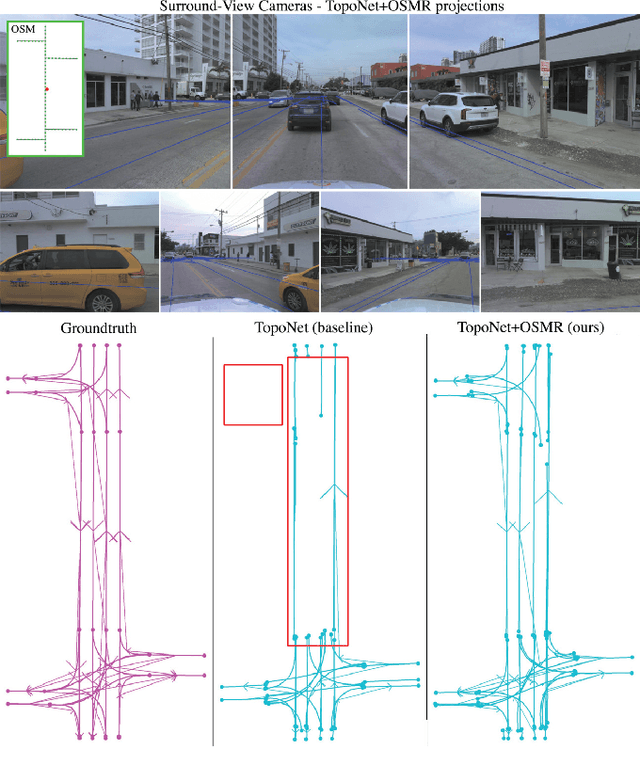

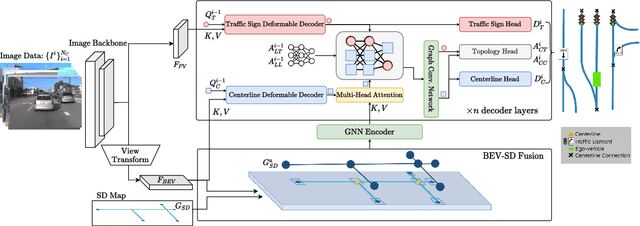
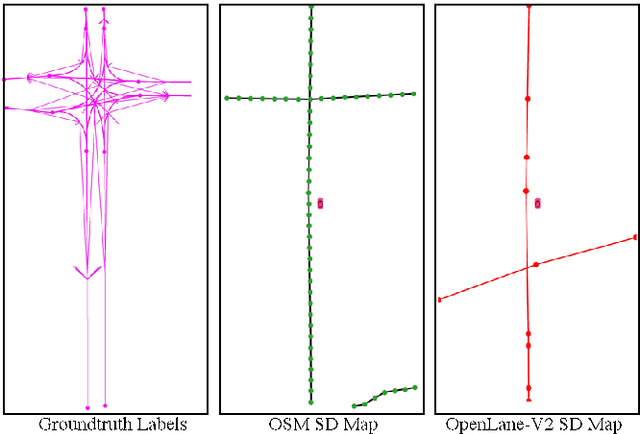
Abstract:Autonomous driving for urban and highway driving applications often requires High Definition (HD) maps to generate a navigation plan. Nevertheless, various challenges arise when generating and maintaining HD maps at scale. While recent online mapping methods have started to emerge, their performance especially for longer ranges is limited by heavy occlusion in dynamic environments. With these considerations in mind, our work focuses on leveraging lightweight and scalable priors-Standard Definition (SD) maps-in the development of online vectorized HD map representations. We first examine the integration of prototypical rasterized SD map representations into various online mapping architectures. Furthermore, to identify lightweight strategies, we extend the OpenLane-V2 dataset with OpenStreetMaps and evaluate the benefits of graphical SD map representations. A key finding from designing SD map integration components is that SD map encoders are model agnostic and can be quickly adapted to new architectures that utilize bird's eye view (BEV) encoders. Our results show that making use of SD maps as priors for the online mapping task can significantly speed up convergence and boost the performance of the online centerline perception task by 30% (mAP). Furthermore, we show that the introduction of the SD maps leads to a reduction of the number of parameters in the perception and reasoning task by leveraging SD map graphs while improving the overall performance. Project Page: https://henryzhangzhy.github.io/sdhdmap/.
CoCoGesture: Toward Coherent Co-speech 3D Gesture Generation in the Wild
May 27, 2024



Abstract:Deriving co-speech 3D gestures has seen tremendous progress in virtual avatar animation. Yet, the existing methods often produce stiff and unreasonable gestures with unseen human speech inputs due to the limited 3D speech-gesture data. In this paper, we propose CoCoGesture, a novel framework enabling vivid and diverse gesture synthesis from unseen human speech prompts. Our key insight is built upon the custom-designed pretrain-fintune training paradigm. At the pretraining stage, we aim to formulate a large generalizable gesture diffusion model by learning the abundant postures manifold. Therefore, to alleviate the scarcity of 3D data, we first construct a large-scale co-speech 3D gesture dataset containing more than 40M meshed posture instances across 4.3K speakers, dubbed GES-X. Then, we scale up the large unconditional diffusion model to 1B parameters and pre-train it to be our gesture experts. At the finetune stage, we present the audio ControlNet that incorporates the human voice as condition prompts to guide the gesture generation. Here, we construct the audio ControlNet through a trainable copy of our pre-trained diffusion model. Moreover, we design a novel Mixture-of-Gesture-Experts (MoGE) block to adaptively fuse the audio embedding from the human speech and the gesture features from the pre-trained gesture experts with a routing mechanism. Such an effective manner ensures audio embedding is temporal coordinated with motion features while preserving the vivid and diverse gesture generation. Extensive experiments demonstrate that our proposed CoCoGesture outperforms the state-of-the-art methods on the zero-shot speech-to-gesture generation. The dataset will be publicly available at: https://mattie-e.github.io/GES-X/
 Add to Chrome
Add to Chrome Add to Firefox
Add to Firefox Add to Edge
Add to Edge